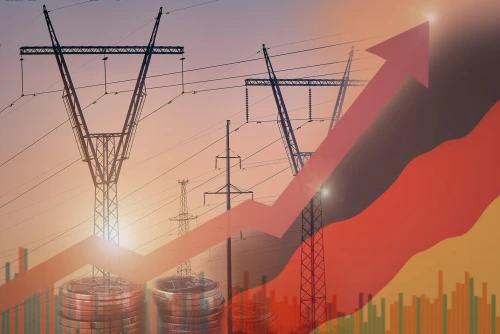
April 24th, 2025
Join our Italian Energy Day on 20 May – Book now
White hydrogen, a naturally occurring and potentially abundant source of clean energy, is gaining attention for its ability to provide a low-carbon alternative to traditional hydrogen production methods.

White hydrogen is almost pure hydrogen naturally formed in the earth. It potentially forms through mineral and water reacting underneath the ground. While we’re not yet sure how white hydrogen deposits occur yet, it is hoped they could become a viable source of energy.
You’ve likely encountered hydrogen as a fuel source before, with some of the most well-known types including green, blue, grey, and pink hydrogen.
Produced using renewable energy, green hydrogen is one of the most well-known but also expensive forms of hydrogen as a fuel source. Grey hydrogen uses fossil fuels to produce a viable fuel, while pink hydrogen utilises nuclear energy and blue hydrogen harnesses the power of natural gas. Most of these hydrogen generation methods require fossil fuels as part of the production process, creating CO2. White hydrogen is naturally forming, so it does not require fossil fuels. This zero-emission aspect and natural abundance of white hydrogen, coupled with the fact that it only produces heat when it burns, makes white hydrogen a low-carbon fuel source.
White hydrogen is naturally occurring underground in the earth. We look at some of the areas where hydrogen has been found.
White hydrogen deposits have been found in Africa, Spain, France, Oman, USA and Australia.
One of the most notable white hydrogen discoveries was in Mali, Africa in 2012, when an ex-well borehole leaked close to pure hydrogen.
Natural white hydrogen deposits have been found in several locations in Europe, with Spain and France being two prominent areas of discovery. Last year, production started drilling more than a million tonnes of white hydrogen in Spain. Helios Aragón, an exploration agency, discovered the huge reservoir in the northeast of the country.
As a natural resource, white hydrogen offers benefits that make it a low-carbon solution to the renewable energy sector.
For white hydrogen to be created, the right conditions need to be present for the deposits to occur. As far as we know, creating these conditions does not require carbon emissions to take place, making white hydrogen a zero-emissions production process. Current processes that generate other types of hydrogen are less clean and can include reforming methane or gasifying coal, which are not zero-emission.
White hydrogen may be a cheaper alternative to green hydrogen. Currently kilogram of green hydrogen can cost around €5. By comparison, white hydrogen can have a low cost of €0.50 per kilogram.
White hydrogen's renewable abilities could revolutionise the renewable energy sector. Fossil fuels can take millions of years to regenerate, whereas white hydrogen replenishes itself constantly. This continued generation of hydrogen would make it a good solution for heavy industry or heavy transport that isn’t able to use e-batteries. The aviation and heavy manufacturing industries may also benefit from using white hydrogen.
As with all explorative technologies, white hydrogen has its sticking points. We examine the elements that make it difficult to implement.
Because white hydrogen is formed naturally in specific geological conditions, many deposits are not simple or straightforward to locate or extract. It’s thought that many of the deposits of white hydrogen are located in impossible-to-access areas in the ocean.
Scientific reports suggest that white hydrogen, as a naturally occurring resource, may be prone to leaking, which could have negative environmental impacts. The main issue with white hydrogen leaking into the atmosphere is that the chemical reaction can affect the molecules that destroy greenhouse gases in our environment, which can reduce the effectiveness of carbon reduction efforts. White hydrogen must be handled correctly to ensure it doesn’t leak into the atmosphere, and advanced technology must be developed to assist with this issue.
Currently the technology we have in place to prevent leaking white hydrogen is lacking, but there are other issues in scaling up white hydrogen production. White hydrogen also needs a lot of space for capture and needs high temperatures to be liquified - up to -253°C. There currently isn’t a reliable pipe network to distribute hydrogen effectively, making it an expensive technology, though there are hopes that it can be re-routed through infrastructure that already exists for fossil fuels. Still, some research shows hydrogen could crack pipes currently used for gas distribution.
In France, vast deposits of white hydrogen have been found in the Lorraine region after methane testing was carried out by University of Lorraine’s GeoRessources Lab, France’s National Centre for Scientific Research (CNRS) and energy producer La Française de l’Energie. Currently, exploration is taking place to determine the amount of white hydrogen deposited, but it is thought there could be up to 46 million tonnes, more than half of all grey hydrogen produced worldwide.
With the current estimates of white hydrogen costing €0.50 per kilogram vs. €5 per kilogram for green hydrogen, white hydrogen has an opportunity to make hydrogen a more competitive fuel source in the energy market. As the price of white hydrogen goes down, it could potentially reset the overall cost of the hydrogen market, offering a lower-cost and lower-carbon renewable energy solution.
Providing a low-carbon solution to the renewable industry will help organisations achieve net-zero emissions goals. They can opt to consume an energy type that produces lower carbon emissions as opposed to fossil fuels or even more energy-intensive types of hydrogen, such as green.
As research and technology advance, white hydrogen has the potential to become a game-changer in the clean energy sector, offering a cost-effective and sustainable alternative to fossil fuels.
Get accurate insights into the future price of green hydrogen for the German market.

April 24th, 2025

April 23rd, 2025

April 22nd, 2025